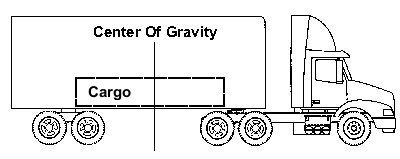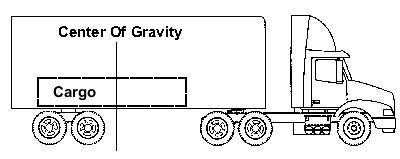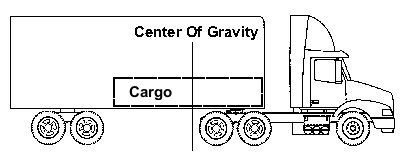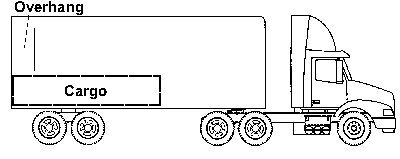Review Questions - Click On The Picture To Begin...

What will be the ultimate limitation that prevents you from putting the trailer tandems as far to the rear of the trailer as possible?
- The center of gravity of the cargo
- The kingpin to trailer tandem length limitations
- The load rating of the steer tires
- The hole structure of the trailer tandem slider rail
Quote From The CDL Manual:
The kingpin to trailer tandem length limitations will prevent you from going too far back with your trailer tandems
Next
If unsure of the exact location of the center of gravity of your cargo, where would you rather have the center of gravity located if you couldn't get it centered?
- Directly centered above the trailer tandems
- A little closer to the front than to the rear
- About 5-10 feet in front of the trailer tandems
- About 15 feet behind the tractor drive axles
Quote From The CDL Manual:
If unsure of the exact location of the center of gravity of your cargo, you'd rather have the load a little closer to the front than to the rear. You can slide the trailer tandems forward as far as you would like to compensate for too much weight on the nose of the trailer, but the kingpin to trailer tandem length limitations will prevent you from going too far back with your trailer tandems.
TruckingTruth's Advice:
A lot of times you'll be loading mixed cargo which will make it quite difficult to determine the exact center of gravity of the load. So when you're making your best guess, try to make sure it's a little forward of the center point between the drive axles and trailer tandems. That will give you the best chance of being able to adjust the trailer tandems so that the load will be legal.
Prev
Next
Where in the trailer could you place cargo so that the weight applied to the trailer tandems is greater than the weight of the cargo itself?
- Directly above the drive axles
- Directly above the front axle of the trailer tandems
- In the overhang portion of the trailer behind the center point of the trailer tandems
- Slightly in front of the halfway point between the tractor drives and trailer tandems
Quote From The CDL Manual:
Because the trailer pivots up and down at the kingpin above the drive axles, the floor of the trailer acts as a lever pushing down against the trailer tandems when freight is loaded into the overhang portion of the trailer. The further back you load the freight into the overhang portion of the trailer, the more leverage it creates. The net effect of this leverage is that you're putting more weight on the trailer tandems than the cargo itself weighs, and you will actually take a little bit of weight off the drive axles at the same time.
Prev
Next
What is the cargo's center of gravity?
- The average height of the cargo above the trailer floor.
- The overall length of the cargo after being loaded into the trailer.
- The distance from the front of the trailer to the center point of the cargo.
- The center point of the cargo's weight.
Quote From The CDL Manual:
The center of gravity location of the cargo is the center point of the cargo's weight. In other words, if all of the cargo in your trailer was one solid block, the center of gravity would be the point that the entire block would balance upon like a teeter totter.
TruckingTruth's Advice:
Sometimes you will load 22 pallets that all weigh the same. That makes it simple to determine the center of gravity. But often times you'll have a mixed product and you'll have to look over what's being put on the truck so you can get the weight of the cargo roughly centered between the drive axles and trailer tandems.
Prev
Next
If you are able to exert 200 pounds of force against an object but you are only exerting 50 pounds of force to do so, what method are you applying to make this happen?
- Center of gravity
- Leverage
- Momentum
- Centrifugal Force
Quote From The CDL Manual:
Using a lever on an object allows you to exert more force upon the object than the amount of force you're actually exerting against the lever itself. In other words, you might rig a lever that can lift a 250 pound boulder but requires only 50 pounds of force against the lever itself.
TruckingTruth's Advice:
Loading the cargo behind the center point of the trailer tandems exerts leverage against the trailer tandems. You will actually put more weight on the trailer tandems than the cargo loaded behind the trailer tandems actually weighs. At the same time, you'll be taking weight off the drive axles.
Prev
Next
Ideally, where would you like the cargo's center of gravity located?
- About 10 feet to the rear the center point of the trailer
- Just slightly behind the tractor's drive axles
- Roughly centered between the steer axle and the trailer tandems
- Centered between your drive axles and your trailer tandems.
Quote From The CDL Manual:
You'll want to have the cargo loaded into the trailer so that the center of gravity is centered between your drive axles and your trailer tandems.
TruckingTruth's Advice:
If the center of gravity of the cargo is too far to the front or rear of the vehicle, it is entirely possible that you will not be able to get your axle weights legal without reloading the cargo itself.
Prev
Next
If you load cargo into the overhang portion of the trailer, what will be the result?
- You will evenly distribute the load across the drive axles and trailer tandems, but the steer axle could now be overweight
- The center of gravity will be moved toward the front of the trailer and you will have to slide the trailer tandems all the way to the rear of the 53 foot trailer
- You will put more weight on the trailer tandems than the cargo itself weighs, and you will actually take a little bit of weight off the drive axles at the same time.
- You will put less weight on the trailer tandems than the cargo itself weighs, and you will actually add a little bit of weight to the drive axles at the same time.
Quote From The CDL Manual:
Because the trailer pivots up and down at the kingpin above the drive axles, the floor of the trailer acts as a lever pushing down against the trailer tandems when freight is loaded into the overhang portion of the trailer. The further back you load the freight into the overhang portion of the trailer, the more leverage it creates. The net effect of this leverage is that you're putting more weight on the trailer tandems than the cargo itself weighs, and you will actually take a little bit of weight off the drive axles at the same time.
Prev
Finish
Please select an option













 TT On Facebook
TT On Facebook